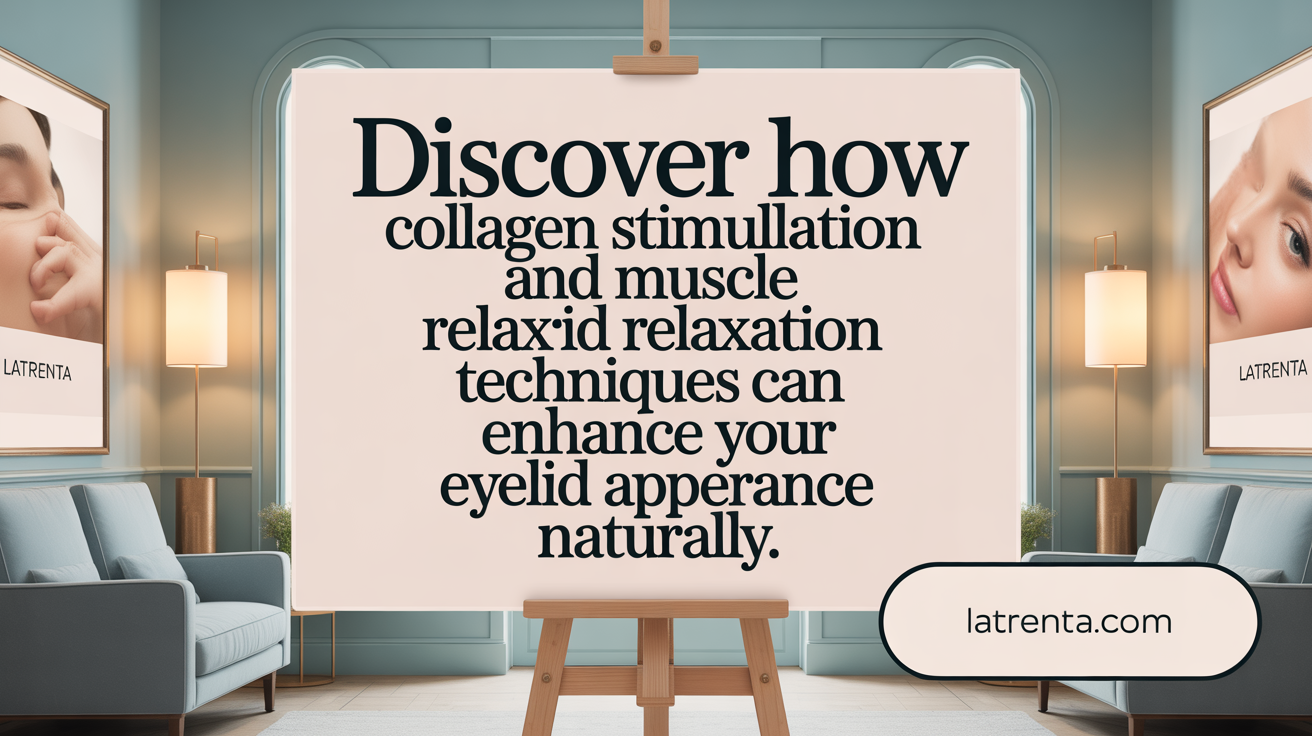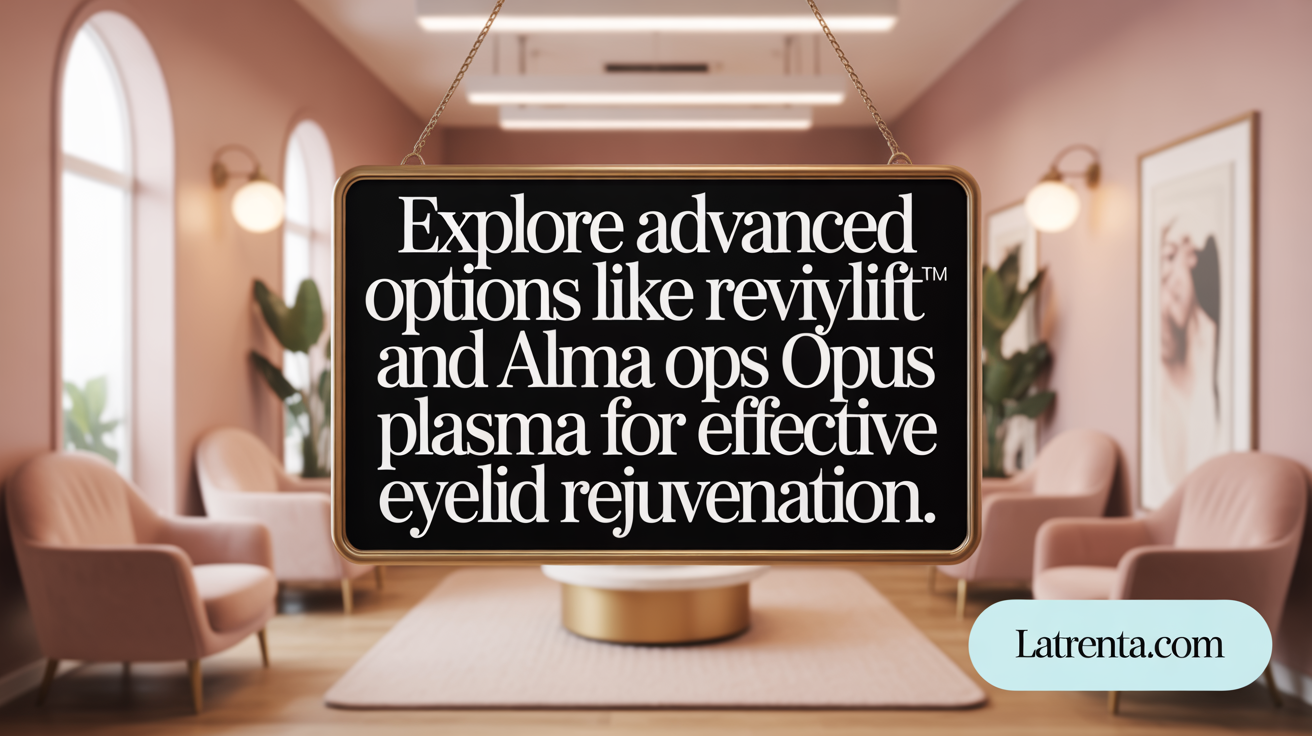Introduction to Non-Surgical Eye Lifts
As interest grows in aesthetic treatments that avoid the risks and recovery time of surgery, non-surgical eye lifts have become a popular option for individuals seeking to rejuvenate their eyelids. This article explores a range of non-invasive procedures, from advanced laser resurfacing to injectable neuromodulators, evaluating their effectiveness, mechanisms, safety, and how they compare to traditional surgical blepharoplasty. Whether you’re curious about cutting-edge therapies like Alma Opus Plasma or considering more established treatments like Botox and dermal fillers, we provide a comprehensive guide to what actually works in non-surgical eyelid lifting.
Understanding Common Non-Surgical Eye Lift Options and Their Effectiveness
Many individuals seeking eyelid rejuvenation opt for non-surgical treatments that offer less invasive alternatives to traditional surgery. These procedures include laser skin resurfacing, dermal fillers, Botox, PRP injections, radiofrequency devices, and plasma fibroblast therapy.
Laser treatments, such as ablative fractional CO2 lasers or non-ablative options like Fraxel or eMatrix, work by removing damaged skin layers and stimulating collagen production. These procedures improve skin texture, reduce fine lines, and can tighten loose skin around the eyelids, providing noticeable improvements with minimal recovery time.
Dermal fillers, particularly hyaluronic acid-based products like Restylane, Juvederm, and Belotero, add volume, support the skin, and can reshape the brow or eyelid contours. They effectively diminish under-eye hollows, dark circles, and crow's feet, creating a more youthful appearance.
Botox and other neuromodulators relax muscles responsible for wrinkles, especially around the frown lines, crow's feet, and forehead, sometimes resulting in a subtle brow lift that opens the eyes.
Radiofrequency devices—including Ultherapy, ThermiTight, and Lutronic Genius—use ultrasound or radio waves to heat deeper skin layers, stimulating collagen growth and resulting in skin tightening.
Plasma fibroblast therapy employs a small electrical arc to create tiny skin injuries, promoting contraction and collagen synthesis. This technique can effectively tighten mild to moderate eyelid skin and is often preferred for its office-based, minimally invasive nature.
PRP injections, derived from the patient’s own blood, enhance collagen production, skin texture, and elasticity.
Effectiveness of these treatments depends heavily on the severity of aging signs. For mild to moderate laxity and wrinkle formation, non-surgical options can provide noticeable improvements, often lasting from four months up to two years with regular maintenance.
However, for severe drooping or significant skin excess, surgical options like blepharoplasty remain the most lasting and dramatic solution. Non-surgical procedures are generally best suited for those with early signs of aging or those hesitant to undergo surgery.
Most non-invasive treatments are temporary, requiring repeat sessions to maintain results. For example, Botox and fillers typically last 3–6 months, while laser skin tightening might last up to two years.
People considering these options should consult with qualified specialists to develop a personalized treatment plan tailored to their skin condition and aesthetic goals. While non-surgical methods provide subtle and natural-looking outcomes with minimal risk, they are not substitutes for surgical correction when more significant eyelid lifting is needed.
How Non-Surgical Eye Lift Treatments Work to Elevate and Tighten

How do non-surgical eye lift treatments work to lift or tighten the eyelids?
Non-surgical eye lift options achieve their results mainly by promoting the body's natural ability to enhance skin quality and support structures around the eyes. These treatments often focus on stimulating collagen, the protein responsible for skin's firmness and elasticity. As we age, collagen decreases, leading to sagging and wrinkles.
Procedures such as laser resurfacing and radiofrequency devices work by delivering heat energy into the deeper skin layers. This controlled heating stimulates collagen production, resulting in skin tightening, wrinkle reduction, and a more lifted appearance over time. For example, laser treatments like fractional CO2 or non-ablative lasers remove damaged skin and encourage new, healthy skin growth.
In addition, radiofrequency treatments such as ThermiTight or Ultherapy employ ultrasound or radio waves to penetrate into the dermis, further stimulating collagen synthesis.
Muscle relaxation plays a significant role as well. Botox® (botulinum toxin type A) and similar neuromodulators are injected into specific muscles around the eyebrows and eyelids. By relaxing these muscles, they reduce the downward pull, allowing the eyelids and brow area to lift slightly for a more open-eyed appearance. This effect is temporary and typically lasts about 4 to 6 months.
Dermal fillers also contribute to eyelid elevation. Hyaluronic acid-based fillers are injected to restore volume in the brow area, under-eye hollows, or cheekbones. Filling in these areas provides structural support that helps lift the eyelids and smooth out sagging skin.
Lastly, plasma fibroblast therapy utilizes a device that creates a plasma arc, causing small controlled skin contractions. By inducing skin shrinkage, it tightens loose skin around the eyelids and reduces wrinkles. The process results in a natural, non-invasive tightening effect with minimal downtime.
Overall, these treatments leverage collagen production, muscle relaxation, and tissue contraction mechanisms. The goal is to lift and tighten the eyelids naturally, offering a youthful look without surgical intervention.
Safety Profiles and Expected Outcomes of Non-Surgical Eyelid Rejuvenation

What are the safety considerations and expected results of non-surgical eye lift treatments?
Non-surgical eye lift options are popular because they are minimally invasive and typically have fewer risks than traditional surgery. Treatments like dermal fillers, Botox, platelet-rich plasma (PRP), radiofrequency devices, laser therapy, and plasma fibroblast technology are common choices. These procedures aim to improve skin laxity, smooth wrinkles, reduce puffiness, and restore a more youthful appearance.
Most treatments are considered safe when performed by experienced, board-certified professionals. Side effects tend to be mild and temporary, often including swelling, redness, bruising, or slight discomfort shortly after the procedure. Serious complications are rare but can include infection or unwanted asymmetry, which underscores the importance of professional supervision.
Expected results vary depending on the specific treatment and individual factors like age, skin condition, and the severity of eyelid concerns. Typically, patients notice an immediate or near-term tightening and smoothing effect, with more significant improvements appearing over the following weeks as collagen stimulation takes effect.
The longevity of results differs among therapies. For example, Botox effects last approximately 3 to 6 months, while dermal fillers can last from 6 months to a year or more. Laser treatments and plasma fibroblast procedures tend to provide longer-lasting improvements, often from 1 to 3 years.
Post-care is crucial for optimal outcomes. Patients should avoid excessive heat, sun exposure, and certain skin products during recovery to reduce side effects and promote healing. Regular follow-up treatments may be necessary to maintain the desired look.
While non-surgical options are effective for mild to moderate signs of eyelid aging, they do not offer the same dramatic or permanent results as eyelid surgery. However, when performed properly, these treatments provide a safe, quick, and natural-looking enhancement with minimal downtime. Consulting with a qualified specialist helps ensure realistic expectations and the best possible outcome.
Non-Surgical Versus Surgical Eyelid Lifts: Benefits and Limitations
How do non-surgical eye lifts compare with surgical eyelid lifts in terms of benefits and limitations?
Non-surgical eyelid lift options, including treatments like BOTOX®, dermal fillers, laser resurfacing, and radiofrequency therapy, are designed to provide subtle improvements with minimal downtime. These procedures typically involve less risk, reduced discomfort, and fast recovery times—often just a few hours to days. They are particularly effective for early signs of aging such as fine lines, wrinkles, mild skin laxity, and volume loss around the eyes.
However, their results tend to be temporary, lasting from a few months up to a year, requiring repeat treatments to maintain the desired look. For example, BOTOX® relaxes muscles to smooth out wrinkles, while dermal fillers restore volume and enhance the eyebrow arch. Laser treatments and RF microneedling stimulate collagen production to tighten skin.
In contrast, surgical eyelid lifts, known as blepharoplasty, address more significant aging changes by removing excess skin, fat, and tightening muscles. This procedure offers more dramatic and long-lasting results, with some outcomes lasting 7 years or longer. While blepharoplasty provides a definitive correction for severe sagging and drooping eyelids, it involves a longer recovery period—typically 1 to 2 weeks—and carries higher risks such as infection, scarring, or asymmetry.
Suitability based on severity of eyelid aging
For mild to moderate aging signs, non-surgical options are often sufficient and preferable due to their safety, quick recovery, and minimal invasiveness. These treatments help improve the appearance subtly and can be repeated as needed.
Patients with significant eyelid drooping, pronounced excess skin, or large bags under the eyes usually benefit more from surgical intervention. Blepharoplasty provides a more definitive solution to restore a youthful look through the removal of sagging skin and protruding fat.
When to consider combined approaches
Some individuals may opt for a combination of surgical and non-surgical treatments to optimize results. For example, a surgical lift can address excess skin, while neurotoxin injections and fillers can refine brow elevation and volume enhancement. This tailored approach allows patients to enjoy quick improvements with non-invasive methods while achieving long-term correction through surgery.
Overall, the decision between non-surgical and surgical eyelid lifts depends on factors like the severity of aging, personal preferences, and desired permanence. Consulting with a qualified specialist can help determine the most suitable option for each individual, ensuring a harmonious and natural-looking result.
Detailed Look at Specific Non-Surgical Eyelid Procedures: Reviylift™ and Alma Opus Plasma

What are some specific non-surgical procedures used for eyelid lifting, such as Reviylift™ or Alma Opus Plasma?
Non-surgical eyelid lifting has become increasingly popular as a less invasive alternative to traditional surgery. Among the advanced options available, Reviylift™ and Alma Opus Plasma are prominent treatments.
Reviylift™ is a specialized procedure designed to lift, tighten, and brighten the eyes without surgery. This technique combines a medical-grade phenol peel solution with micro-punch incisions around the eyelids, allowing targeted rejuvenation of the periocular region. It effectively restores a more youthful look by tightening loose skin and elevating the eyelids. Patients typically undergo minimal discomfort, and the micro-punch incisions tend to heal in less than a week. The procedure can be tailored by incorporating additional treatments such as dermal fillers or Botox to enhance results.
Alma Opus Plasma employs fractional plasma technology that uses RF energy to create tiny micro-injuries in the skin. These controlled injuries stimulate the body’s natural collagen production, leading to skin tightening, wrinkle reduction, and overall skin rejuvenation around the eyes. Alma’s device, Colibri, utilizes micro-plasma energy which allows precise resurfacing, making it suitable for delicate areas like the eyelids.
These treatments are quick, typically completed within 20-30 minutes, and are safe for all skin types. They offer significant benefits such as minimal downtime, no external scars, and a lower risk of complications compared to surgical procedures.
Laser eyelid tightening devices, featuring FDA-approved radiofrequency or RF pixel applicators, are also used to promote skin contraction and smooth fine lines. These techniques are effective in producing noticeable improvements over a few sessions.
Overall, these non-invasive options provide effective, safe, and convenient alternatives to surgical eyelid lifts. They are especially appealing for individuals with mild to moderate skin laxity who wish to avoid the risks and recovery period associated with surgery.
Safety and recovery considerations
Both Reviylift™ and Alma Opus Plasma have favorable safety profiles when performed by experienced professionals. Common side effects include swelling, redness, and minor scabbing, typically resolving within a few days to weeks.
Reviylift™ involves micro-punch techniques that heal quickly, with most patients returning to normal activities within a week.
Alma Opus Plasma’s fractional RF technology causes minimal discomfort and requires no significant downtime. Mild redness and swelling are common post-treatment but generally subside within a few hours to days.
It is crucial to have these procedures performed by board-certified specialists who can assess individual skin conditions, set realistic expectations, and provide appropriate pre- and post-treatment care.
Results and treatment duration
Results from Reviylift™ and Alma Opus Plasma are typically noticeable within a few weeks after the procedure as collagen begins to regenerate. Most patients see continued improvement over the next 2-3 months.
The effects can last from 3 to 5 years depending on skin quality, age, and lifestyle factors.
Treatments may be repeated 1-3 times to achieve optimal results. Maintenance sessions are recommended based on individual aging patterns and skin condition.
In conclusion, Reviylift™ and Alma Opus Plasma represent advanced non-surgical options for eyelid rejuvenation, combining safety, efficacy, and convenience. They are suitable choices for patients seeking subtle to moderate improvements with minimal downtime.
Choosing the Right Non-Invasive Treatment for Eyelid Rejuvenation

What factors should be considered when choosing an effective non-invasive treatment for eyelid rejuvenation?
Selecting the most suitable non-invasive procedure for eyelid rejuvenation involves evaluating several important factors. First, consider the patient's specific concerns, such as skin laxity, volume loss, fine lines, wrinkles, dark circles, or pigmentation. For example, laser resurfacing or RF microneedling can effectively improve skin texture and tightness, while dermal fillers are better suited for restoring volume and supporting the eyelid structure.
The severity of skin laxity and the presence of excess skin influence treatment choices. Mild to moderate looseness might respond well to skin tightening treatments like Thermage or plasma fibroblast therapy, whereas more pronounced sagging often requires surgical options like blepharoplasty.
Safety and recovery time are also critical. Non-invasive treatments generally offer fewer risks, minimal discomfort, and shorter downtimes—making them appealing for individuals with busy lifestyles or those cautious about surgical risks.
Longevity of results varies as well. While procedures like Botox and fillers last from a few months up to a year, treatments such as laser resurfacing or plasma pen may last several years but might require maintenance sessions.
Patient age, overall health, and prior cosmetic procedures should also guide the treatment plan. A comprehensive assessment by a qualified specialist ensures that the chosen modality aligns with the patient’s anatomy, expectations, and personal health profile.
Ultimately, a tailored combination of treatments—such as pairing dermal fillers with non-surgical skin tightening or neuromodulators—can optimize both aesthetic outcomes and longevity, all while minimizing risks and downtime.
Cost Considerations and Common Questions on Non-Surgical Eyelid Lifts

What is the approximate cost of non-surgical eyelid lift treatments?
The expenses for non-surgical eyelid lift procedures vary based on the specific treatment selected. Typically, dermal fillers such as Restylane or Juvederm cost between $682 and $915 per syringe, delivering immediate volume restoration and wrinkle smoothing. Botox treatments, which help lift brows and relax muscles causing sagging, generally cost about $376 per session.
More advanced skin tightening options like Ultherapy usually average around $1,802 per session, while laser resurfacing treatments such as the Butterfly Lift™ or fractional CO2 laser procedures range from $1,600 to $2,800. The overall cost for the whole range of non-invasive options tends to hover around $1,000.
Because prices differ widely depending on geographic location, provider expertise, and specific treatments, patients should seek detailed quotes during consultation. It’s also important to note that these treatments are usually not covered by insurance and require ongoing maintenance to sustain results.
How long do non-surgical eyelid lift results last, and what is involved in maintenance?
Results from non-surgical eyelid treatments are generally temporary. For example, Botox and dermal fillers can last from 3 to 12 months, requiring repeat injections to maintain a youthful look. Skin tightening devices like Ultherapy or ThermiTight often produce effects lasting up to two years, but multiple sessions may be necessary to achieve optimal results.
Laser skin resurfacing treatments tend to last longer, with improvements lasting from 1 to 3 years, although individual aging factors can influence longevity. Procedures that stimulate collagen, such as radiofrequency treatments or plasma fibroblast therapy, may also last several years, especially with proper skincare and maintenance sessions.
To sustain benefits, patients often need follow-up treatments. Developing a customized plan with a qualified specialist ensures the best possible outcomes and helps adjust treatments over time.
Addressing frequently asked patient concerns
Patients commonly inquire whether non-surgical eyelid lifts are effective and how long their results will last.
Does a non-surgical eyelid lift really work, and how long do the results last?
Non-surgical eyelid lifts can significantly improve the appearance by reducing sagging, puffiness, and fine lines, creating a more refreshed look. While these procedures do not replicate the dramatic results of surgical blepharoplasty, they are effective for subtle to moderate improvements. Results typically last from 6 months up to 2 years, depending on the treatment type and individual factors.
What are the typical costs for these treatments?
Costs vary widely, with simple injections like Botox costing around $376 per session, and more involved procedures like laser resurfacing reaching $2,800. Overall, most patients spend approximately $1,000 per treatment cycle, but it’s essential to consult with a specialist to get exact estimates.
In summary, non-surgical eyelid lifts provide effective, minimally invasive options to rejuvenate the eye area. They offer shorter recovery times and less risk compared to surgery but require periodic maintenance to preserve results. Consulting with a qualified cosmetic dermatologist or plastic surgeon helps tailor the best plan suited to individual goals and budget.
| Treatment Type | Approximate Cost | Duration of Results | Notes |
|---|---|---|---|
| Botox | $376 | 3-4 months | Best for fine lines and brow lift |
| Dermal Fillers | $682-$915 | 6-12 months | Adds volume, lifts eyebrows |
| Ultherapy | $1,802 | Up to 2 years | Collagen stimulation with ultrasound |
| Laser Resurfacing | $1,600-$2,800 | 1-3 years | Improves skin texture and tightness |
| RF Microneedling | $500-$2,500 | Up to 2 years | Collagen boost and skin tightening |
This information emphasizes the importance of understanding costs and realistic expectations when considering non-surgical eyelid enhancement options.
Final Thoughts on Non-Surgical Eye Lifts
Non-surgical eye lift treatments offer a spectrum of minimally invasive options for those seeking to refresh and rejuvenate the delicate eyelid area without undergoing surgery. While they cannot replicate the dramatic and long-lasting results of surgical blepharoplasty, procedures such as laser resurfacing, Botox, dermal fillers, and plasma fibroblast therapy provide effective solutions for mild to moderate aging concerns with minimal downtime and fewer risks. Selecting the appropriate treatment requires a personalized approach based on individual skin condition, aesthetic goals, and medical history. Consultation with an experienced specialist is essential to design a safe, effective, and customized regimen. Ultimately, non-surgical eye lifts can restore youthfulness to the eye area, enhancing overall facial harmony with subtle yet meaningful improvements.
References
- Does A Non Surgical Eyelid Lift Work? (Before and After Photos)
- Nonsurgical Eye Lift: What Is It and Does It Work? - Healthline
- Non Surgical Eyelid Lifting | Plasma Fibroblast Eyelid Treatment
- Non-Surgical Alternatives to Eyelid Surgery - Westlake Dermatology
- Non-invasive Radio Frequency Treatment for Droopy Eyelids
- Non Surgical Eye Lift NYC, Lower Eyelid Lift - Dr. Michele Green M.D.
- No-Surgical Eye Lift in New York - NYC - Dr. Yael Halaas
- Can You Get an Eyelid Lift Without Surgery? - Skin Med Spa
